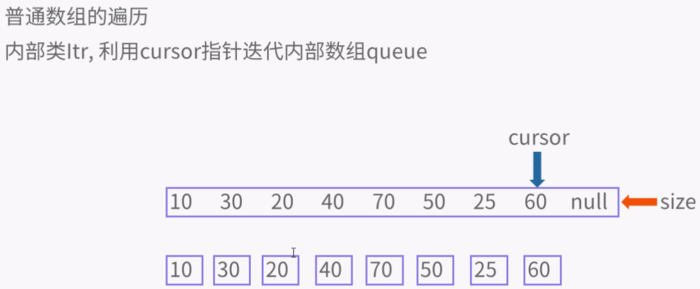作者:chroalist | 来源:互联网 | 2023-10-16 16:17
publicbooleanhasNext(){returncursor<size||(forgetMeNot!null&am

public boolean hasNext() {
return cursor
(forgetMeNot != null && !forgetMeNot.isEmpty());
}
//内部的迭代器,就是数组的迭代,迭代指针cursor,
public E next() {
if (expectedModCount != modCount)
throw new ConcurrentModificationException();
if (cursor < size)
return (E) queue[lastRet = cursor++];
if (forgetMeNot != null) {
lastRet = -1;
lastRetElt = forgetMeNot.poll();
if (lastRetElt != null)
return lastRetElt;
}
throw new NoSuchElementException();
}

扩容:
private void grow(int minCapacity) {
int oldCapacity = queue.length;
// 小于64扩大为原来2倍,大于等于64扩大为原来1.5倍,
int newCapacity = oldCapacity + ((oldCapacity <64) ?
(oldCapacity + 2) :
(oldCapacity >> 1));
// overflow-conscious code
if (newCapacity - MAX_ARRAY_SIZE > 0)
newCapacity = hugeCapacity(minCapacity);
queue = Arrays.copyOf(queue, newCapacity);//丢弃原来的数组,指向新的数组,
}
public class zusheQueue {
private static PriorityQueue queue = new PriorityQueue(3);
public static void main(String[] args) {
queue.offer(80);
queue.offer(60);
queue.offer(70);
queue.offer(40);
queue.offer(20);
queue.offer(10);
queue.offer(90);
queue.offer(22);
queue.offer(15);
queue.offer(4);
queue.offer(1);
System.out.println(queue);//[1, 4, 20, 22, 10, 70, 90, 80, 40, 60, 15] 数组实现最小堆
System.out.println("出来 "+queue.poll());
System.out.println("出来 "+queue.poll());
System.out.println("出来 "+queue.poll());
System.out.println("出来 "+queue.poll());
/*出来 1
出来 4
出来 10
出来 15 出来最小的*/
System.out.println(queue);
Iterator i = queue.iterator();
while(i.hasNext()) {
System.out.print(i.next() + " ");//1 4 20 22 10 70 90 80 40 60 15
}
List l = Arrays.asList(7,85,4,9,5,85,74,5,8);
PriorityQueue p = new PriorityQueue<>(l);
System.out.println(p);
}
}


private void siftUpComparable(int k, E x) {
Comparablesuper E> key = (Comparablesuper E>) x;
while (k > 0) {
int parent = (k - 1) >>> 1; //无符号右移
Object e = queue[parent];
if (key.compareTo((E) e) >= 0)
break;
queue[k] = e;
k = parent;
}
queue[k] = key;
}







private void siftDownComparable(int k, E x) { // k = 0
Comparablesuper E> key = (Comparablesuper E>)x;
int half = size >>> 1; // 非叶子节点
while (k < half) {
int child = (k <<1) + 1; // child = 左孩子
Object c = queue[child]; // c = 左孩子
int right = child + 1;//right = 右孩子
if (right
((Comparablesuper E>) c).compareTo((E) queue[right]) > 0) //有右孩子,并且左孩子大于右孩子
c = queue[child = right];// c = 右孩子,child = 右孩子
if (key.compareTo((E) c) <= 0) //key小于右孩子,就是小于所有孩子
break; //结束循环
queue[k] = c; // 否则key大于右孩子,k位置是右孩子,就是较小的孩子
k = child; //指针k值为right右孩子的位置, 比较都是根据指针位置比较,放的时候才放对象。
}
queue[k] = key;
}



构造函数:

public PriorityQueue(Collectionextends E> c) {
if (c instanceof SortedSet) {
SortedSetextends E> ss = (SortedSetextends E>) c;
this.comparator = (Comparatorsuper E>) ss.comparator();
initElementsFromCollection(ss);
}
else if (c instanceof PriorityQueue) {
PriorityQueueextends E> pq = (PriorityQueueextends E>) c;
this.comparator = (Comparatorsuper E>) pq.comparator();
initFromPriorityQueue(pq);
}
else {
this.comparator = null;
initFromCollection(c);
}
}
private void initFromCollection(Collectionextends E> c) {
initElementsFromCollection(c);
heapify();
}
private void initElementsFromCollection(Collectionextends E> c) {
Object[] a = c.toArray();
// If c.toArray incorrectly doesn't return Object[], copy it.
if (a.getClass() != Object[].class)
a = Arrays.copyOf(a, a.length, Object[].class);
int len = a.length;
if (len == 1 || this.comparator != null)
for (int i = 0; i )
if (a[i] == null)
throw new NullPointerException();
this.queue = a;
this.size = a.length;
}
private void heapify() {
for (int i = (size >>> 1) - 1; i >= 0; i--) //(size >>> 1) - 1就是找到第一个非叶子节点,然后从下到上从右到左,
siftDown(i, (E) queue[i]);
}


public E poll() {
if (size == 0)
return null;
int s = --size;
modCount++;
E result = (E) queue[0]; //取出第0个元素
E x = (E) queue[s]; //取出最后一个元素
queue[s] = null; // 最后一个元素置为空
if (s != 0)
siftDown(0, x); // 最后一个元素不要先不要放在第0个元素位置,比较之后确定位置了再放。放置的都是左右孩子,改变的是k的值,key不到最后不放。
return result; //返回第0个元素
}
private void siftDownComparable(int k, E x) {
Comparablesuper E> key = (Comparablesuper E>)x;
int half = size >>> 1;
while (k < half) {
// sI, sV是左右子节点的较小位置和值,k,key是要比较的元素和准备放的位置(落之前要比较在放)
int sI = (k <<1) + 1; // 较小位置=左孩子索引
Object sV = queue[sI];//较小值=左孩子
int right = sI+ 1;
if (right
((Comparablesuper E>) sV ).compareTo((E) queue[right]) > 0) //有右孩子,并且左孩子大于右孩子,
sV = queue[sI= right]; // 较小位置=右孩子索引,较小值=右孩子,
if (key.compareTo((E) sV ) <= 0) //key比左右都小,放上去,
break;
queue[k] = sV ;//否则key比子节点要大,交换位置,并且自己准备放在sl的位置。放置的都是左右孩子,改变的是k的值,key不到最后不放。
k = sI; //自己放在sl的位置之前,也要跟子节点比较一下,在放。
}
queue[k] = key;//key放在k的位置
}